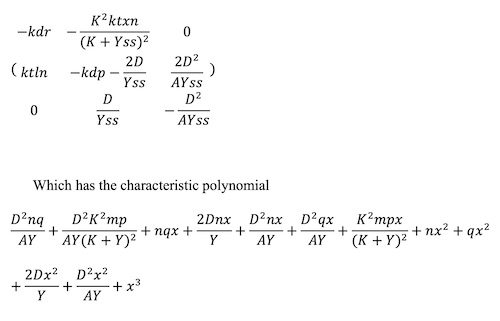Very happy to announce our new preprint from Karina Perlaza and Ivan Zamora in which we tried to understand how transcription is regulated during flagellar regeneration in Chlamydomonas and found that IFT has an unexpected (by us) role
biorxiv.org/content/10.110…
biorxiv.org/content/10.110…
This paper is part of our long-term project to use flagellar length control in Chlamydomonas to understand the general question of organelle size control. An important aspect in organelle size is regulation of the building blocks, and that's what this paper addresses
One great advantage of Chlamy flagella is how easy it is to induce organelle regeneration: just pH shock, and the flagella pop off. then they grow back in about an hour. during that time, the genes that encode flagellar proteins all get upregulated 



classic papers from Joel Rosenbaum and his lab back in the 60's showed that synthesis of new flagellar precursor proteins (like tubulin) matters: if you block translation, flagella only grow back to half length.
rupress.org/jcb/article/41…
rupress.org/jcb/article/41…
but how does the cell "know" to turn these genes on? what's the cue? Maybe its a stress response to the pH shock? nope - when we looked at expression levels in "bld" mutants, which lack flagella, genes did not turn on after pH shock. 

so then we started thinking about how regeneration gets triggered in other organisms, in particular, how crustaceans control eyestalk regeneration. the eyestalk secretes a hormone that keeps regeneration at bay, so when you chop off the eyestalk, the inhibition is removed
so we considered two models in Chlamy: a "repressor production" model where the flagellum generates a repressor, for example like repressive Gli function, and a "repressor sequestration" model where a repressor is made in the cell body and sequestered in the growing flagellum. 

we did some math and showed that both models give rise to a stable steady-state flagellar length. that wasn't obvious because the sequestration model is sort of positive feedback - faster growth leads to less repression and thus even faster growth.. 

we also did some simulations and could show that both models could produce a pulse of gene expression like what actually happens. oh wait I forgot to show a figure of what the actual data looks like, here it is. note: expression (red) is highest when growth (blue) is fastest 

so the main feature is a single peak of expression that corresponds to the time when flagella are growing the fastest. both of our models can account for this. are there any predictions that could distinguish the two models? 

the two models make different predictions about mutants like fla3, which at the permissive temperature have full length flagella, but which regrow them very slowly because of a defect in IFT. (FLA3 is part of the IFT kinesin-2).
if flagella produce the repressor, then mutants like fla3 should have MORE gene expression, since it takes longer to produce enough repressor to turn the genes off.
if flagella sequester the repressor, then mutants like fla3 should have LESS gene expression, because as the repressor gets made in the cytoplasm, it isn't getting pumped into the flagella as quickly, so it shuts genes off before they can really get going.
modeling confirms this intuition. in the simulation results, green is the wt parameter set and red is a simulated mutant in which IFT has been dialed down to simulate the effect of the fla3 mutation. see the difference. 

so when we measure gene expression in fla3 mutant cells after pH shock (at the permissive temp so they start out with flagella, but have a long delay in regenerating them) the result is.....
and its not just fla3, we see essentially the same effect in the fla8 and fla10 mutants, which affect the other subunits of the IFT kinesin motor, and which have the same phenotype: full length flagella prior to pH shock but delayed regrowth.
so the bottom line is that the data fit the repressor sequestration model, but not the repressor production model. of course this doesnt' prove the sequestration model. its possible that the IFT machinery is playing a direct role in transcriptional control.
what's the repressor, you ask? we don't know, but these results finally give some guidance about how to find it. for instance, maybe we need to look for mutants that constitutively drive flagellar gene expression, rather than ones that don't let the genes turn on.
yep, its time to get back to work on this one...meanwhile, check out our paper and let us know if you have any suggestions.
one last note: Ivan Zamora, the co-first author, was the first person to join my lab. as a recent #SFSU graduate he wanted to get some research experience, and the first gel run in my lab, which is still on our wall, was run by Ivan.
if you want to read another paper by Ivan, check out this one - here we used a sensitive genetic assay in Chlamydomonas to show that a mutant which decouples centrioles from the mitotic spindle causes increased chromosome loss rates
bmcbiol.biomedcentral.com/articles/10.11…
bmcbiol.biomedcentral.com/articles/10.11…
and the other first author, Dr. Karina Perlaza, graduated last year from UCSF after publishing an amazing study of Crescerin function in flagellar assembly
pubmed.ncbi.nlm.nih.gov/34818077/
AND a huge study of the chloroplast unfolded protein response
pubmed.ncbi.nlm.nih.gov/31612858/
pubmed.ncbi.nlm.nih.gov/34818077/
AND a huge study of the chloroplast unfolded protein response
pubmed.ncbi.nlm.nih.gov/31612858/
• • •
Missing some Tweet in this thread? You can try to
force a refresh







